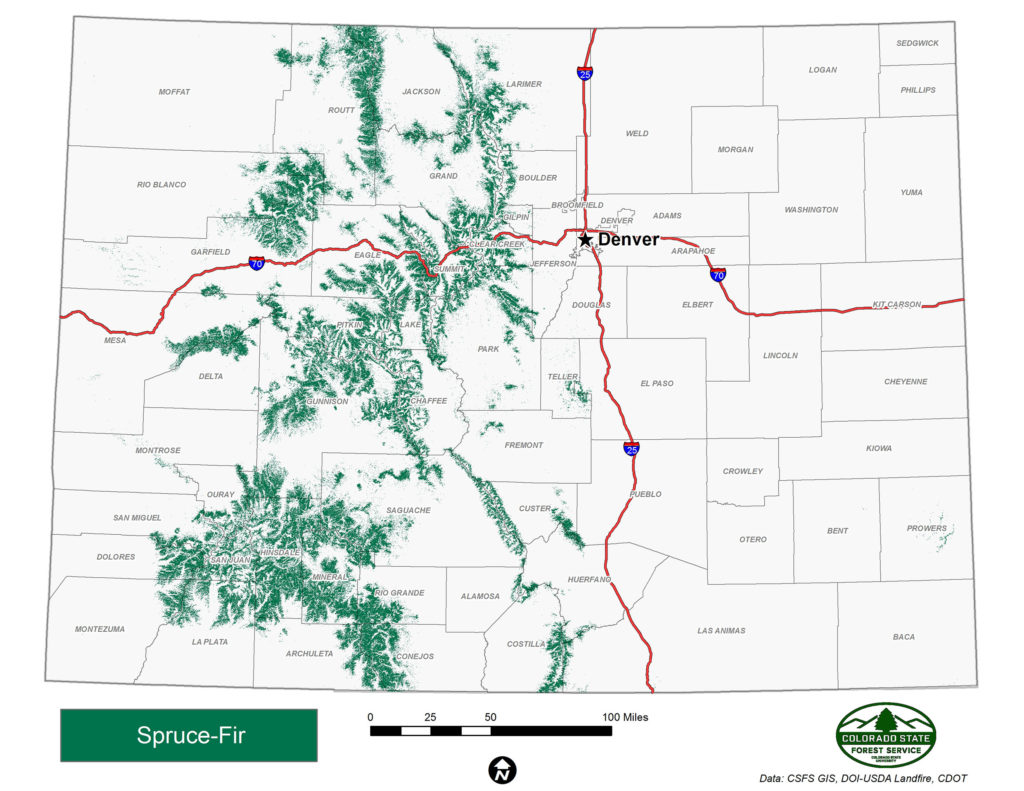Spruce Fir
Spruce-fir is among the most extensive forest types in Colorado, covering approximately 4.6 million acres or 19 percent of the state’s forested lands.
Click on the map to view full size
Spruce-fir also has the largest number of acres in public ownership (Benson and Green 1987)1. The slow-growing Engelmann spruce (Picea engelmannii), in association with the smaller, narrow-crowned subalpine fir (Abies lasiocarpa), forms the vast green vistas so typical of Colorado’s high country or subalpine zone, but aspen and other conifers also may occur. The spruce-fir combination often results in a climax-type forest at high elevations, despite the existence of many uneven-aged stands. This is because both species are shade tolerant and tend to quickly repopulate shaded gaps in the forest.
The return interval for naturally occurring fires within the spruce-fir forest may be 300 years or longer. Unlike many other Colorado forest types, spruce-fir forests are not adapted to fire. Thin bark and the persistence of dead lower limbs increases the spruce’s susceptibility to fire as well as the likelihood of intense crown fires and tree mortality. In the case of a stand-replacing fire, it may take as long as 300-400 years for a spruce-fir forest to regenerate.
Threats to Spruce-Fir Forests
Threats to spruce-fir include fire and native insects such as spruce beetle and western spruce budworm, particularly in times of drought or when trees are otherwise stressed.
At lower elevations, Engelmann spruce forests can contain more moisture than any other stand type in the state. Snow packs may exist well into summer and water yield from these forests is very important.
The Importance of Spruce-Fir Forests
Spruce-fir forests are highly valued for their contributions to water supply, recreation and wood products. The soft wood and uniform color makes spruce ideal for boards, mine props, plywood and musical instruments. Although there are fewer uses for subalpine fir, it can be made into lumber, produces fine Christmas trees and its aromatic resin serves as a basis for “pine-scented” products and adhesives (CSFS 2008)2.
Spruce-fir forests also provide important habitat to a number of subalpine wildlife species, including the red squirrel, snowshoe hare, pine marten, boreal owl, Clark’s nutcracker and three-toed woodpecker.
Learn More
Detailed information about the Engelmann spruce and subalpine fir may be found by visiting our Colorado’s Major Tree Species page and selecting the species from the menu on the left.
Text Citations
1Benson, R.E., and Green, A.W. 1987. Colorado’s Timber Resources. Resource Bulletin INT-48. Ogden, UT: U.S. Department of Agriculture, Forest Service.
2Colorado State Forest Service. 2008 Report: The Health of Colorado’s Forests – Special Issue: High Elevation Forests (9.5 MB PDF).
Data Sources
NatureServe. 2018. International Ecological Classification Standard: Terrestrial Ecological Classifications. NatureServe Central Databases. Arlington, VA. U.S.A. Data current as of 28 August 2018.
2017 Colorado Wildfire Risk Assessment, Colorado State Forest Service.


